This article was medically reviewed by Shaune Wallace, OD and by wikiHow staff writer, Hunter Rising. Dr. Wallace is an Optometrist in Nevada with over 14 years of optometry experience. He received his OD from the Southern California College of Optometry in 2006 and is a member of the American Optometric Association.
There are 20 references cited in this article, which can be found at the bottom of the page.
wikiHow marks an article as reader-approved once it receives enough positive feedback. In this case, 100% of readers who voted found the article helpful, earning it our reader-approved status.
This article has been viewed 644,360 times.
So you've finally mastered putting in your contact lenses, but now it's time to take them out. Whether you have soft, flexible lenses or harder, rigid ones, removing your contacts is really easy and only takes a few seconds. After you take your contacts out, it's important to clean and store them safely before you wear them again. Read on for everything you need to know to clean hard or soft lenses, plus how to keep them safe when you're not wearing them!
Steps
Removing Soft Contact Lenses
-
1Wash and dry your hands. Be sure to wash your hands with antibacterial soap and warm water for the best clean. Scrub for at least 20 seconds to remove any harmful bacteria that could get in your eye. Then, dry your hands thoroughly with a clean towel.[1]
- Avoid touching your eyes with dirty hands to prevent getting an infection.
-
2Look straight ahead into a mirror. Stand in the bathroom in front of a mirror so you can see what you’re doing. Try to keep your focus straight ahead rather than looking in different directions so your contacts stay in the middle of your eye.[2]
- Plug your sink or lay a towel over your counter to catch your contacts in case you drop them.
- Check if your contacts are in the right position by closing one eye at a time and testing your vision. If your vision is blurry, then your contact may have slipped off the front of your eye. Close your eye and push the lens around over your eyelid to put it back into position.[3]
Advertisement -
3Hold your eye open with your fingers. Use your non-dominant hand to pull your top eyelid straight up. Place the middle finger of your dominant hand on your lower lid and gently drag it down and away from your eye so it’s wide open.[4]
- Do your best to stay relaxed so your eye doesn’t twitch and make it harder to remove your contacts.
-
4Pinch the lens between your thumb and index finger to pull it off your eye. Lean in closer to the mirror so you can see better. Look up and carefully touch the bottom of your contact lens with the tip of your index finger on your dominant hand. Slide the lens down toward the bottom of your eye so you can get a better grip. Then, squeeze the bottom of the lens between your finger and thumb so it curves off of your eye and comes out easily.[5]
- Be as gentle as you can as you remove your contact so you don’t accidentally scratch or tear it.
- If you have trouble gripping the lens, wet your fingers with a saline solution or contact cleaner to rewet your contacts.
-
5Try sliding the lens toward the side of your eye if you can’t pinch it. Keep holding your eye open with your non-dominant and dominant hand. Touch your contact with the pad of your dominant index finger and slide the contact towards the outer corner of your eye. Since the contact is soft, it will bunch up near the corner of your eye and fall out easily.[6]
- Pulling your contact to the side is a great way to remove the lens if you have long fingernails and don’t want to scratch your eye.
-
6Grip the lens with padded tweezers if you don’t want to touch your eye. Padded tweezers made to remove contacts have dull points with silicone so you can get a better grip on your contacts. Hold your eye open with your non-dominant hand and use the tweezers with your dominant hand. Look straight ahead and carefully pinch the bottom of the contact lens with the tweezer. Pull the contact straight out from your eye.[7]
- Avoid using standard tweezers to take out your contacts since they’re sharp and could damage your eyes or your contacts.
Removing Hard or Rigid Contact Lenses
-
1Wash your hands thoroughly. Scrub your hands with warm water and antibacterial hand soap any time before you touch your eyes or contacts. Rinse all of the soap off of your hands and pat your hands dry on a fresh, clean towel.[8]
- Avoid touching your contacts with wet hands since water could contain impurities or bacteria that could cause infections.
-
2Look straight into a mirror. Lean as close as you comfortably can to the mirror so you can get the best view. Try to focus directly on your eyes rather than looking at your fingers or anywhere else.[9]
- Looking straight ahead also helps prevent you from flinching.
-
3Pull the corner of your eye toward the side of your head. Use your non-dominant hand, and set the pad of your middle finger on the outer corner of your eye. Gently pull your skin to the side as far as you can.[10]
- Pulling the corner of your eye tight helps lift the contact lens away from your eye so it’s easier to remove.
-
4Blink hard to make your contact fall out. Open your eyes as wide as you can before squeezing your eyelids together tightly. If the hard contact lens doesn’t fall out right away, try blinking a few more times until the lens comes loose. It will either fall onto your cheek or onto the counter below you where you can easily pick it up.[11]
- If you’re taking your contacts out over a sink, plug the drain or set a towel over it so you don’t lose your lenses.
-
5Push the lens toward your nose if you have trouble blinking it out. Hold your upper eyelid open with the middle finger of your non-dominant hand. Keep your lower eyelid steady with the middle finger of your dominant hand. Slowly push your eyelids from the outer corner of your eyes toward your nose to force the lens out from your eye.[12]
-
6Try using a plunger removal tool if you can’t get the lens out on your own. A contact removal tool has a suction cup on the end that sticks to hard contact lenses. Wet the plunger with contact solution. Hold your lower eyelid down with your non-dominant hand and press the suction cup on the lower third of your contact lens. Pull the lens up and then straight out of your eye.[13]
- Pushing on the side of your eyelid with your finger can help loosen a stubborn contact lens.
- Avoid putting the plunger in the center of the contact since it will create too much suction and be difficult to remove the lens.
Cleaning and Storing Your Contacts
-
1Clean your lens case before using it. Rub a sterile disinfecting solution onto your contact case. Give it another rinse with fresh sterile solution to get rid of any residue. Then, wipe the case dry with a clean tissue or napkin.[14]
- You can clean the case right before you remove your contacts, but you can also do it right after you put your contacts in.
- Avoid using water to clean your contact lens case since it could contaminate your lenses and cause infections.
- Replace your case for your contact lenses every three months.[15]
-
2Put new, clean contact solution in the case. Empty out your contact case and fill it with fresh solution from the bottle. Avoid reusing old solution that was leftover since it could have bacteria that would transfer onto your contacts.[16]
- Make sure you use a sterile solution and not a saline solution. While saline will keep lenses hydrated, you can’t properly disinfect them without the right solution.[17]
-
3Work on 1 lens at a time. To avoid mixing up your lenses, only take out and clean one of your lenses at a time. That way, you can still see what you’re doing out of one eye while you clean the other. Try to get into the routine of always taking out your lenses in the same order every day so you’re less likely to mix them up.[18]
-
4Rub contact cleaner solution on the lens to clean it. Hold the lens in the palm of your hand and wet it with some of your contact cleaner solution. Then, softly use the pad of your finger to clean the lens for about 15 seconds to remove buildup and microbes on the surface.[19] Flip the contact over to ensure you clean both sides.[20]
- Try your best not to scratch at your contact lens with your nail so you don’t damage it.
- Thoroughly cleaning your contact lenses each day reduces the risk of eye infections or other contact-related complications.[21]
-
5Place the contact in the case. Make sure you put your contact lens into the side of the case labeled for the correct eye. Set your clean lens into the case and let it soak in the solution.[22]
- You may need to place more solution in the case after you place the contact lens inside. Make sure the case has enough solution to completely cover the lens.
- If you have disposable contacts, throw them away instead of saving them.
-
6Repeat the process for your other eye. Remove the contact from your other eye and clean it just like you did the first one. Now that you have both lenses out, put on a pair of glasses so you can see what you’re doing. Thoroughly rinse your other lens before putting it into the other side of the case.
-
7Leave your contacts in the solution for about 4–6 hours. Close and seal your case tightly to ensure it doesn’t get contaminated with any dust or bacteria while your lenses soak. Keep your case in a cool, dry place while you wait for the solution to completely disinfect your lenses. When they’re finished cleaning, you can put them back in your eyes like normal.[23]
- This also gives your eyes time to rest and helps to avoid eye strain.
- Hydrogen peroxide-based cleaners need the full 4–6 hours to convert to saline, or else your eyes may sting or get irritated when you put your contacts in. You can take contacts out early and wear them if you leave them in a multipurpose cleaner.[24]
Expert Q&A
Did you know you can get expert answers for this article?
Unlock expert answers by supporting wikiHow
-
QuestionCan you use solution in the eye while the contact is still in ?
 Shaune Wallace, ODDr. Wallace is an Optometrist in Nevada with over 14 years of optometry experience. He received his OD from the Southern California College of Optometry in 2006 and is a member of the American Optometric Association.
Shaune Wallace, ODDr. Wallace is an Optometrist in Nevada with over 14 years of optometry experience. He received his OD from the Southern California College of Optometry in 2006 and is a member of the American Optometric Association.
Doctor of Optometry, Southern California College of Optometry
Warnings
- Replace your contacts at least every 3 months to keep them fresh and clean.[26]⧼thumbs_response⧽
- Avoid wearing daily contacts overnight or while you’re sleeping to prevent discomfort and infection.[27]⧼thumbs_response⧽
- If your contact ever feels stuck somewhere in your eye, use a sterile saline solution to flush your eye. If you still cannot remove the lens, seek medical assistance.[28]⧼thumbs_response⧽
References
- ↑ http://www.cdc.gov/contactlenses/protect-your-eyes.html
- ↑ https://coopervision.com/sites/coopervision.com/files/coopervision_contactlensuserguide_ltr.pdf
- ↑ https://youtu.be/-PP7OGkrs_g?t=250
- ↑ https://youtu.be/AmbwrzrINao?t=55
- ↑ https://youtu.be/ZJlhZkmJqwA?t=132
- ↑ https://youtu.be/AmbwrzrINao?t=277
- ↑ https://youtu.be/qQapVSxxFUE?t=286
- ↑ https://www.nei.nih.gov/learn-about-eye-health/healthy-vision/contact-lenses
- ↑ https://youtu.be/qQapVSxxFUE?t=286
- ↑ https://www.optometrists.org/general-practice-optometry/optical/guide-to-contact-lenses/guide-to-hard-contact-lenses/how-to-insert-and-remove-hard-contact-lenses/
- ↑ https://youtu.be/ksUqg8o_qaU?t=262
- ↑ https://www.optometrists.org/general-practice-optometry/optical/guide-to-contact-lenses/guide-to-hard-contact-lenses/how-to-insert-and-remove-hard-contact-lenses/
- ↑ https://youtu.be/5UkYKwHIQyU?t=266
- ↑ https://pi.bausch.com/globalassets/pdf/PackageInserts/Vision-Care//lenses/ultra-all-pib.pdf
- ↑ http://www.aoa.org/patients-and-public/caring-for-your-vision/contact-lenses/what-you-need-to-know-about-contact-lens-hygiene-and-compliance?sso=y
- ↑ https://coopervision.com/sites/coopervision.com/files/coopervision_contactlensuserguide_ltr.pdf
- ↑ http://www.aoa.org/patients-and-public/caring-for-your-vision/contact-lenses/what-you-need-to-know-about-contact-lens-hygiene-and-compliance?sso=y
- ↑ https://uihc.org/health-topics/dos-and-donts-contact-lens-wear
- ↑ https://coopervision.com/sites/coopervision.com/files/coopervision_contactlensuserguide_ltr.pdf
- ↑ https://www.fda.gov/files/about%20fda/published/Looking-Good--Safe-Use-and-Care-of-Contact-Lenses--%28May-2010%29.pdf
- ↑ http://www.cdc.gov/contactlenses/show-me-the-science.html#habits
- ↑ https://www.aoa.org/healthy-eyes/vision-and-vision-correction/contact-lens-care?sso=y
- ↑ http://www.aoa.org/patients-and-public/caring-for-your-vision/contact-lenses/what-you-need-to-know-about-contact-lens-hygiene-and-compliance?sso=y
- ↑ https://www.cdc.gov/contactlenses/care-systems.html
- ↑ https://www.cdc.gov/contactlenses/water-and-contact-lenses.html
- ↑ https://www.cdc.gov/contactlenses/protect-your-eyes.html
- ↑ https://pi.bausch.com/globalassets/pdf/PackageInserts/Vision-Care//lenses/ultra-all-pib.pdf
- ↑ http://www.aoa.org/patients-and-public/caring-for-your-vision/contact-lenses/what-you-need-to-know-about-contact-lens-hygiene-and-compliance?sso=y
About This Article
Removing contact lenses can be difficult at first, but with a little practice in front of a mirror, it’ll be second nature! Start by washing and drying your hands so you don’t transfer any bacteria to your eyes. Then, add a drop of saline to each eye to help lubricate your contacts. Stand or sit in front a well-lit mirror so you can see what you’re doing. Always start with the same eye, so you don’t get your lenses mixed up. With your non-dominant hand, pull your eyelids apart to make sure you don’t blink. While holding your eyelids open, gently grip the lens with the thumb and forefinger of your dominant hand. When you feel the lens start to come out, lift it away from your eye. Put your contact lens in its case and repeat the process for your other eye. For more tips from our Optometry co-author, including how to clean and store your contact lenses, read on!
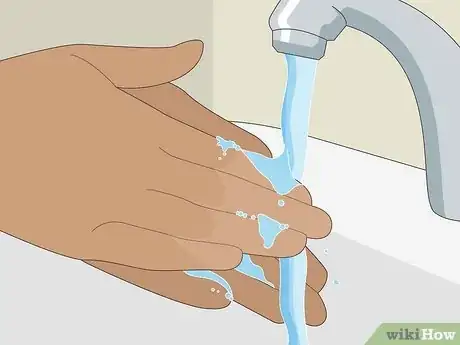
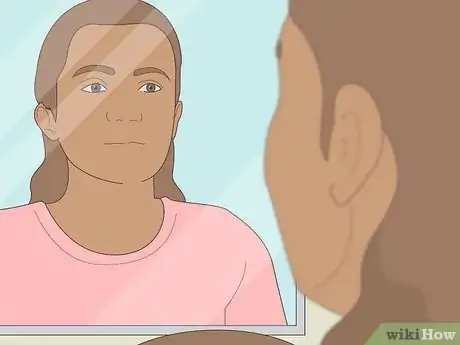
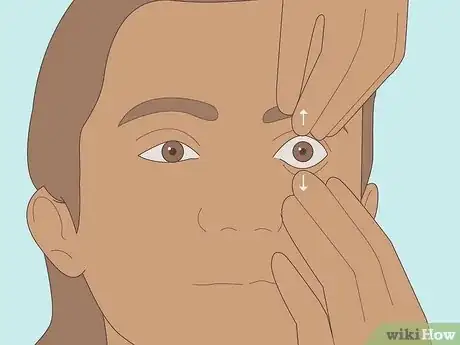
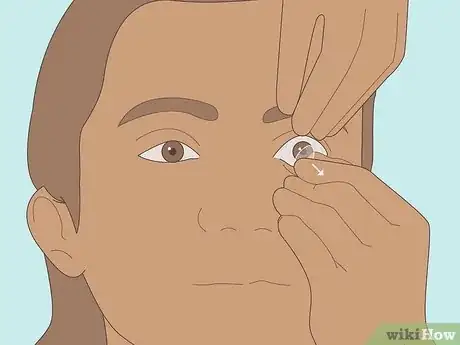

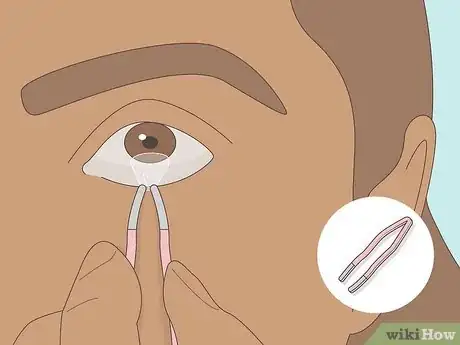
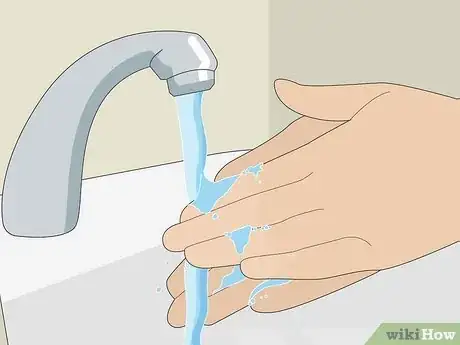
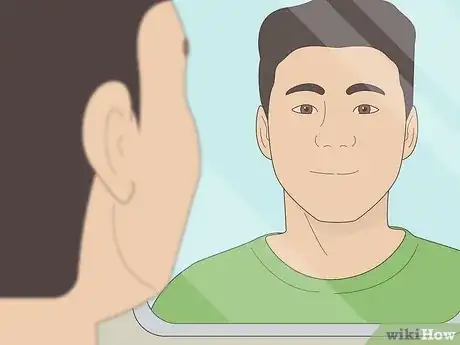
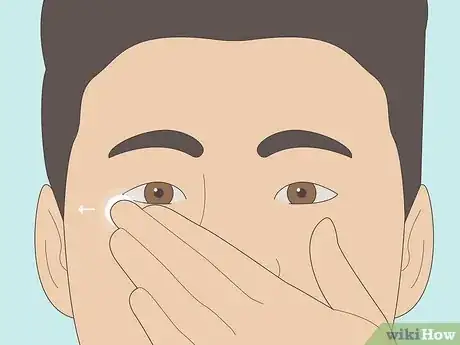
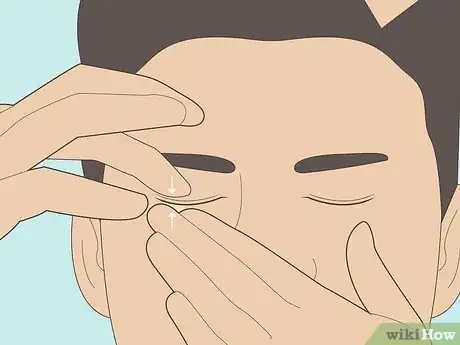
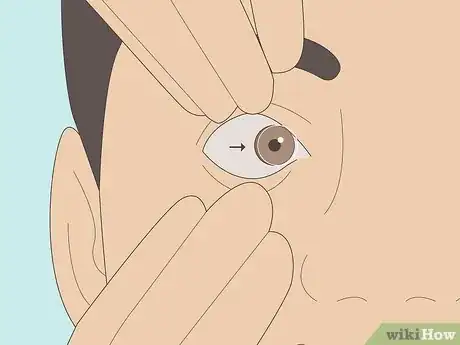
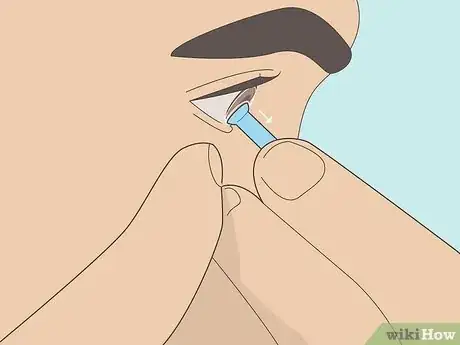
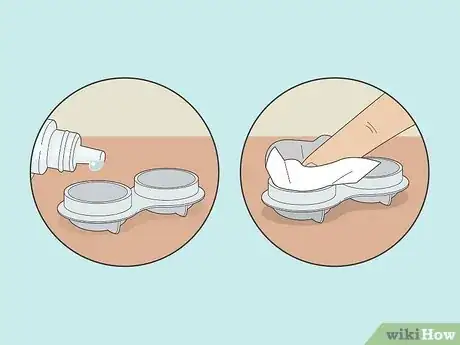
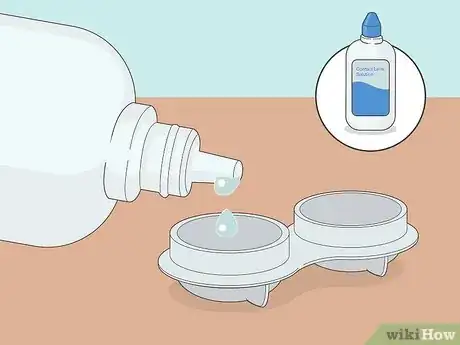

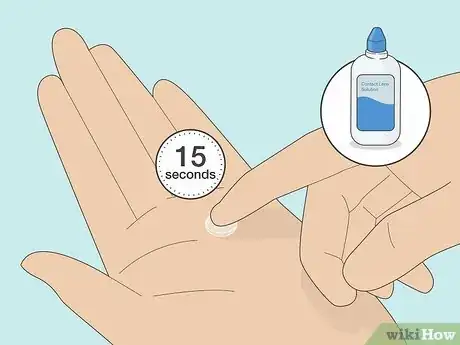
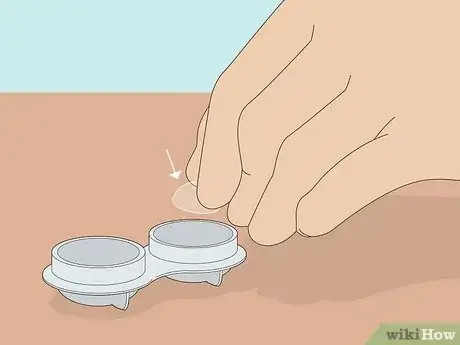

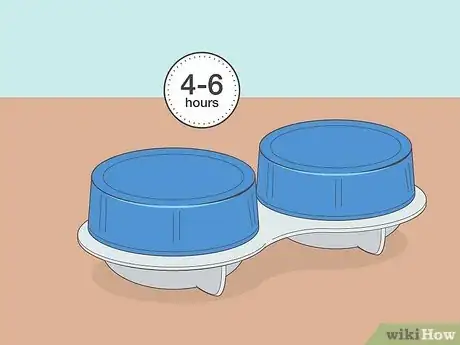
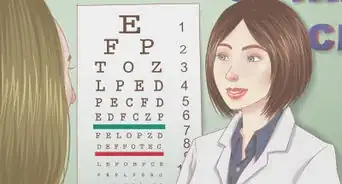
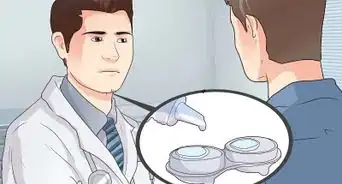


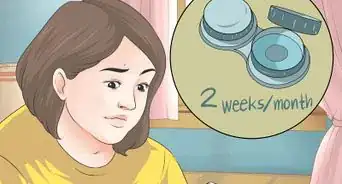
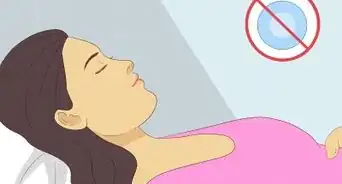

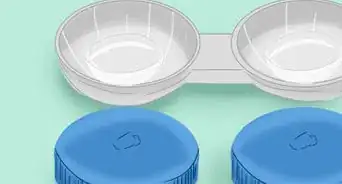



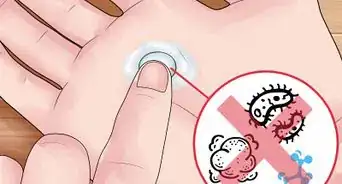
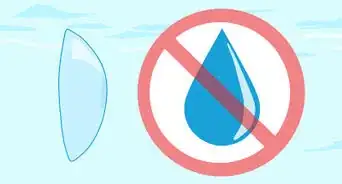











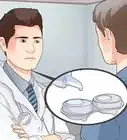




































Medical Disclaimer
The content of this article is not intended to be a substitute for professional medical advice, examination, diagnosis, or treatment. You should always contact your doctor or other qualified healthcare professional before starting, changing, or stopping any kind of health treatment.
Read More...